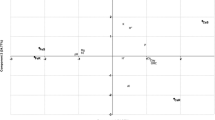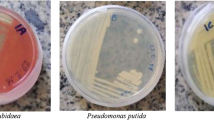Abstract
Fourteen genetically modified lines of alfalfa (Medicago sativa) containing the geneOv from Japanese quail, coding for a methionine-rich protein ovalbumin, were evaluated for nodulation ability and concentration of aerobic bacteria in the rhizosphere. The transgenic lines were derived from a highly regenerable genotype Rg9/I-14-22, selected from cv. Lucia. On selective media, a higher concentration of ammonifying bacteria, bacterial spores, denitrifying and nitrifying bacteria were observed in the rhizosphere of transgenic clonesand, on the other hand, lower concentration of cellulolytic bacteria andAzotobacter spp. compared with the rhizosphere of non-transgenic clone SE/22-GT2. A statistically significant difference in the concentration of all the bacterial types was found between samples taken from two types of substrates (i.e. sterilevs. nonsterile). Higher bacterial concentration (measured as colony forming units per g soil dry mass) were observed for all tested groups of culturable bacteria in the non-sterile substrate. The presence ofAzotobacter spp. was found only in the rhizosphere of plants grown in non-sterile soil in which the highest number of fertile soil particles (97 %) was observed in transgenic clones SE/22-9-1-12 and SE/22-11-1-1S.1. Concentration of bacteria involved in the N cycle in the soil was increased in the rhizosphere of transgenic clones and decreased in the rhizosphere of non-transgenic plants compared with the average value. In spite of some differences in colony numbers in samples isolated from the root rhizosphere of transgenic and non-transgenic alfalfa plants, we could not detect any statistically significant difference between individual lines.
Similar content being viewed by others
References
Cheneby D., Philippot L., Hartmann A., Germon J.C.: 16S rDNA analysis for the characterization of denitrifying bacteria isolates from three agricultural soils.FEMS Microbiol.Ecol. 34, 121–128 (2000).
Di Giovanni G.D., Watrud L.S., Seidler R.J., Widmer F.: Comparison of parental and transgenic alfalfa rhizosphere bacterial communities using Biology GN metabolic fingerprinting and enterobacterial repetitive intergenic consensus sequence-PCR (ERIC-PCR).Microbiol.Ecol. 37, 129–139 (1999).
Donegan K.K., Seidler R.J., Doyle J.D., Porteous L.A., Di Giovanni G.D., Watrud L.S.: A field study with genetically engineered alfalfa inoculated with recombinantSinorhizobium meliloti: effects on the soil ecosystem.J.Appl.Ecol. 36, 920–936 (1999).
Farago J., Hauptvogel P., Kraic J.: Development of a breeding material of alfalfa with high regeneration ability by recurent somatic embryogenesis, pp. 38–39 in O. Chloupek, U. Simon (Eds):Seed Production of Lucerne. Academia, Prague 1997.
Faragó J., Kraic P., Hauptvogel P.: Development of highly regenerable germplasm and genetic transformation of alfalfa, pp. 117–123 in G. Hrazdina (Ed):Use of Agriculturally Important Genes in Biotechnology. IOS Press, Amsterdam-Berlin-Oxford-Tokyo-Washington 2000.
Faragová N., Faragó J.: Comparison of amount of aerobic bacteria in the rhizosphere of transgenic and non/transgenic alfalfa, pp. 95–97 in Proc. 9th Conf.Current Advances in Genetics And Breeding of Agricultural Crops (M. Užík, Ed.), Piešt’any (Slovakia) 2002.
Fraley R.: Sustaining the supply.Biol.Technol. 10, 40–43 (1992).
Gryndler M., Hršelová H., Klír J., Kubát J., Votruba J.: Long-term fertilization affects the abundance of saprotrophic microfungi degrading resistant forms of soil organic.Folia Microbiol. 48, 76–82 (2003).
Jianping Su, Yanqing Wu, Xiaojun Ma, Gaosen Zhang, Huyuan Feng, Yinghua Zhang: Soil microbial counts and identification of culturable bacteria in an extreme by arid zone.Folia Microbiol. 49, 423–429 (2004).
Lottmann J., Berg G.: Phenotypic and genetypic characterization of antagonistic bacteria associated with roots of transgenic and non-transgenic potato plants.Microbiol.Res. 56, 75–82 (2001).
Lukow T., Dunfield P.F., Liesak W.: Use of the T-RFLP technique to assess spatial and temporal changes in the bacterial community structure within an agricultural soil planted with transgenic and non-transgenic potato plants.FEMS Microbiol.Ecol. 32, 241–247 (2000).
Maloney P.E., Van Bruggen A.H.C., Hu S.: Bacterial community structure in relation to carbon environments in lettuce and tomato rhizospheres and in bulk soil.Microbiol.Ecol. 34, 109–117 (1997).
Mattos K.A., Oliveira G.B.: Isolation and characterization ofAzotobacter strains from Brazilian soils.Revista de Microbiologia 28, 252–255 (1997).
Mucha J., Klaudiny J., Klaudinyová V., Hanes J., Šimúth J.: The sequence of Japanese quail ovalbumin cDNA.Nucl.Acids Res. 19, 5553 (1991).
Murashige T., Skoog F.: A revised medium for rapid growth and bioassays with tobacco tissue cultures.Physiol.Plant. 15, 473–497 (1962).
O’Connell K.P., Goodman R.M., Handelsman J.: Engineering the rhizosphere: expressing a bias.Trends Biotechnol. 14, 83–88 (1996).
Paul E.A., Clark F.E.:Soil Microbiology and Biochemistry. Academic Press, New York 1989.
Rosypal S., Hodák K., Martinec T., Kocur M.:General Bacteriology. (In Czech) SPN Publishing House, Prague 1981.
Schinner F., Ohlinger R., Kandeler E., Margesin R.:Methods in Soil Biology. Springer-Verlag, Berlin-Heidelberg 1996.
Schloter M., Dilly O., Munch J.C.: Indicators for evaluating soil quality.Agricult.Ecosyst.Environ. 98, 255–262 (2003).
Schmalenberger A., Tebbe C.C.: Bacterial community in the rhizosphere of a transgenic, herbicide-resistant maize (Zea mays) and comparison to its non-transgenic cultivar Bosphore.FEMS Microbiol.Ecol. 40, 29–37 (2002).
Seidler R., Levin M.: Potential ecological and nontarged effects of transgenic plant gene products on agriculture, silviculture, and natural ecosystems: general introduction.Mol.Ecol. 3, 1–3 (1994).
Siciliano S.D., Germida J.J.: Taxonomic diversity of bacteria associated with the roots of field-grown transgenicBrassica napus cv. Quest, compared to the non-transgenicB. napus cv. Excel andB. napus cv. Parkland.FEMS Microbiol.Ecol. 29, 263–272 (1999).
Sindhu S.S., Sharma H.R., Dadarwal K.R.: Competition amongBradyrhizobium strains for nodulation of green gram (Vigna radiata): use of dark-nodule strain.Folia Microbiol. 48, 83–89 (2003).
Skujins J., Nohrstedt H.O., Odén S.: Development of a sensitive biological method for the determination of low-toxic contamination in soils — I. Selection of nitrogenase activity.Swed.J.Agr.Res. 16, 113–118 (1986).
Somasegaran P., Hoben H.J.:Handbook for Rhizobia. Springer-Verlag, New York 1994.
Soriano S., Walker N.: Isolation of ammonia-oxidizing autotrophic bacteria.J.Appl.Bacteriol. 31, 493–497 (1968).
Strnadová V., Hršelová H., Kolařík M., Gryndler M.: Response of saprotrophic microfungi degrading the fulvic fraction of soil organic matter to different N fertilization intensities, different plant species cover and elevated atmospheric CO2 concentration.Folia Microbiol. 49, 563–568 (2003).
Uhlířová E., Elhottová D., Tříska J., Šantrůčková H.: Physiology and microbial community structure in soil at extreme water content.Folia Microbiol. 50, 161–166 (2005).
Author information
Authors and Affiliations
Rights and permissions
About this article
Cite this article
Faragová, N., Faragó, J. & Drábeková, J. Evaluation of abundance of aerobic bacteria in the rhizosphere of transgenic and non-transgenic alfalfa lines. Folia Microbiol 50, 509–514 (2005). https://doi.org/10.1007/BF02931439
Received:
Revised:
Issue Date:
DOI: https://doi.org/10.1007/BF02931439




